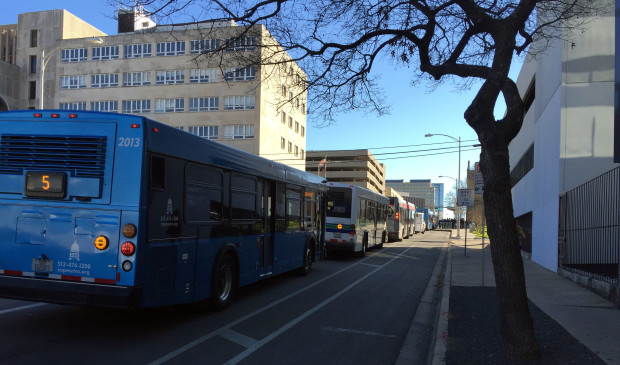Mobility Committee votes to explore transit priority
Thursday, April 7, 2016 by
Caleb Pritchard The City Council Mobility Committee on Wednesday put its imprimatur on an effort to enhance transit service on city roadways.
With a vote of 3-0, Council members Ann Kitchen, Delia Garza and Sheri Gallo endorsed a proposed resolution that calls on city staff to develop recommendations for a transit priority policy. Council Member Don Zimmerman had left the meeting before the vote.
The transit priority policy would provide guidance on how the city works with the Capital Metropolitan Transportation Authority to deploy on city streets a variety of options aimed at giving buses a small advantage over cars.
The vote was preceded by a briefing from Jim Dale, the Austin Transportation Department’s assistant director, and Todd Hemingson, Cap Metro’s vice president of strategic planning and development. Hemingson defined the concept of transit priority to the committee.
“It’s priority bus treatments that improve the operations or the environment that the buses operate in, reducing delays and benefiting bus operations, and improving reliability and attractiveness to patrons or customers,” said Hemingson.
He went on to note that “there are different tools in the toolbox we can use to achieve that,” including transit priority lanes, transit signal priority, queue jumps and bus stop placement.
Hemingson explained that the city of Austin and Cap Metro are already using all four of those configurations in some limited capacity. Buses traveling through downtown Austin on Guadalupe and Lavaca streets cruise on transit priority. Queue jump lights that give buses a short head start have been installed on stoplights at two downtown intersections as well as at North Lamar and Airport boulevards. Also, the premium-fare MetroRapid lines boast transit signal priority, a technology that holds green lights slightly longer as buses running behind schedule approach them.
As for bus stop placement – which Hemingson admitted is not as exciting as the other three – Cap Metro has begun to deploy various bus stops just after intersections instead of just before them.
After Hemingson’s presentation, Zimmerman told him about complaints in his district of empty or nearly empty buses. “When they see that day after day after day, it grates on them that we keep putting this priority on what I consider a failed bus system. And it hurts,” Zimmerman said. “I’m just giving you that feedback from my constituents.”
Kitchen, the chair of the committee as well as a member of Cap Metro’s board, told Zimmerman that it’s important for those constituents to participate in the ongoing effort to craft its latest five-year plan known as Connections 2025. She then allowed Hemingson to respond.
“If a roadway is empty, people celebrate that, but if a bus is empty, then it’s a terrible failure,” he said. “A roadway is a public investment as well, and just like buses, in the peak period they’re very full – but if you go out in the off-peak, they may be empty.” Hemingson also explained that buses are generally not as full the closer they get to the beginning and end of a route.
Not satisfied with that answer, Zimmerman pointed to Cap Metro’s own data that has shown a decline in ridership since 2014.
A clearly bemused Kitchen responded, “I don’t think you’re suggesting that we should never have any buses at all in our community, and I hope you’re not suggesting that, and I know you’re not.”
“But I do have an out-of-the-box thing I could briefly mention,” Zimmerman replied without hesitating. “And that is that we would take the money, the hundreds of millions of dollars we’re spending on a lot of empty buses that don’t pick you up when and where you need to get picked up and they don’t drop you off where you need to go, and we issue vouchers for some kind of ride-share company.”
When he had finished, Kitchen told him, “I think it’s time to move on.”
Six members of the public were in attendance to speak on the proposed transit priority resolution. Each expressed support for the idea and offered a variety of reasons. Roger Cauvin of the Downtown Austin Neighborhood Association even tried to slightly mollify Zimmerman by noting that “it’s a better idea to implement these transit priority measures where there is high ridership already.”
The resolution as passed by the committee directs City Manager Marc Ott to bring back the recommendations for a transit priority policy by Oct. 5.
You're a community leader
And we’re honored you look to us for serious, in-depth news. You know a strong community needs local and dedicated watchdog reporting. We’re here for you and that won’t change. Now will you take the powerful next step and support our nonprofit news organization?









